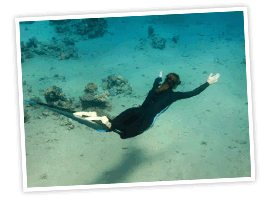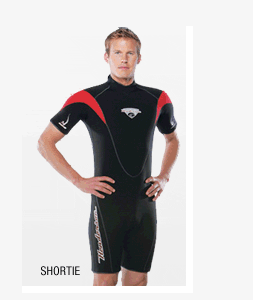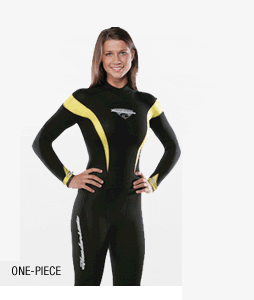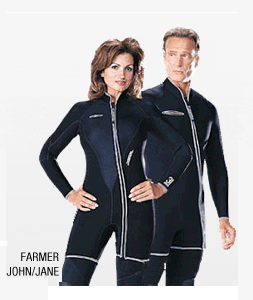Wetsuits Buying Guide
« Back to Buying Guide Index
What Does A Wetsuit Do?
Wetsuits, like the name implies, allow water to come into contact with the diver/snorkeler's skin. Most wetsuits are made out of neoprene, which is a spongy material that contains countless air bubbles. These bubbles trap the diver/snorkeler's body heat, which in turn, warms the water between the suit and the person. The neoprene is waterproof, but because the neck, wrist, and ankle seal are not;, water can enter the suit.
A quality wetsuit is not a cheap piece of scuba gear, but it can mean the difference between a comfortable dive and a miserably cold water experience.
Styles
Shortie
Shortie wetsuits offer the least amount of warmth to the diver or snorkeler. They cover the torso, part of the arms (to the mid-bicep point), and part of the legs (to the mid-thigh region). Shorties keep the diver safe from scrapes that may occur during inadvertent contact with underwater hazards; they can also keep the diver/snorkeler safe from injury due to stinging sea life. Some snorkelers wear shorties to protect themselves from sun damage while spending time in the reflective water, even if the water's temperature doesn't call for insulation gear. Shorties typically zip in the back, allowing for easy donning and ditching of the suit.
One-piece Jumpsuit
One-piece wetsuits are more commonly used by cold-water divers who want to protect their torsos, as well as their entire arms and legs. Jumpsuits typically zip in the back, allowing for easy donning and ditching of the suit. Jumpsuits frequently offer a slightly taller neck/collar, which protects the diver's neck from the cold water and accommodates and hood quite easily. Because a one-piece wetsuit covers the entire arms and legs, the suit offers a more restricted range of motion than does a shortie. The payoff if you'll be a lot warmer in a one-piece wetsuit than you would in a shortie.
Farmer John/Farmer Jane
The Farmer John/Jane style of wetsuit is ideal for cold-water divers who want a little extra insulation around the torso. Farmer John/Jane wetsuits are two-piece garments; the bottoms cover the torso and legs (to the ankles) and the tops cover the torso and arms (to the wrists). This double-layering at the torso keeps the diver's central core warm, which allows the body to focus on keeping the limbs warm.
Thickness
Wetsuits are made in a variety of thicknesses of neoprene. The thicker the neoprene, the warmer you'll stay and the more flexibility you lose. One thing to keep in mind is because neoprene contains air bubbles, the deeper you descend in the water, the thinner your suit will become. If you're comfortable on the surface, you may find yourself feeling cold at depth if your suit isn't thick enough.
2-3mm-thick neoprene is ideal for warm water diving and snorkeling. This thickness slightly insulates the diver from the water and protects the diver from sharp or injury-causing objects at depth. This option is also a great way for snorkelers to protect themselves from the sun. If you tend to feel warm easily, this is probably the best thickness for you if you plan on being in warm or slightly cool water.
5mm-thick neoprene is ideal for warm water divers and snorkelers who tend to feel cold easily. This thick- ness insulates the diver better than a 2 or 3-mm suit; the tradeoff is that the diver's range of motion is slightly reduced because of the thicker material.
7mm-thick neoprene is cold-water gear. It offers the greatest amount of warmth and the least amount of flexibility. The 7mm thickness offers a large amount of air bubbles to trap the heat, which is important, especially as your descend and the water's pressure compresses your suit.
Fit
Now that you've decided which style and thickness of wetsuit will meet your needs, it is time to determine which suit fits you the best.
To don a two-piece wetsuit, put on the bottom section and the Farmer John/Jane section. If the suit has long legs, roll each leg into a big doughnut. Place your foot into the center of the "doughnut" and then roll the suit leg up to your knee. Repeat for the 2nd leg. (If you are trying a shortie, do not roll the suit legs, just insert your feet into the legs and continue with the directions from here). Work both suit legs simultaneously until the suit is around your waist. You will greatly reduce the life of your wetsuit by simply sticking your foot into the suit leg and pulling; that is too much strain on the wetsuit's seams. Next, work the suit up around your torso and securely fasten the Velcro® over your shoulders, if applicable. To don the Farmer John/Jane (or top) section, fasten the zipper (about 3 inches) and then step through the opening with the applicable leg. Next, pull the jacket on and finish zipping the top.
To don a one-piece wetsuit, if the suit has long legs, roll each leg into a big doughnut. Place your foot into the center of the "doughnut" and then roll the suit leg up to your knee. Repeat for the 2nd leg. (If you are trying a shortie, do not roll the suit legs, just insert your feet into the legs and continue with the directions from here). Work both suit legs simultaneously until the suit is around your waist. You will greatly reduce the life of your wetsuit by simply sticking your foot into the suit leg and pulling; that is too much strain on the wetsuit's seams. Next, work the suit up around your torso, work your arms through the sleeves, and then zip the suit closed.
1. Because wetsuits trap your body heat, they need to fit snugly. If a wetsuit is too loose, air will escape the suit. It is important to note that snug does not equate to uncomfortable. If the suit pinches you or if your hands and/or feet start to tingle, it is too small. It is important to note that you will have a reduced range of motion in a well-fitted wetsuit. The thicker the neoprene (necessary for warmth), the less freedom of motion you'll have.
2. Once you're in the wetsuit, look at yourself in a full-length mirror. (It is also handy to have a buddy inspect the suit while youre in it; dive buddies are very helpful - even out of the water!) If the suit bulges anywhere (one common spot is at the small of the back), it is too big. (Slight puckering at the bend of the elbows and knees is common, however.) If you feel slightly restricted when taking a deep breath, the wetsuit fits your torso well.
3. If you've found a suit that is almost perfect, but needs a little tuck here or there, you may want to consider having the wetsuit professionally altered.
Most people need to try on quite a few wetsuits before finding THE suite for them. Scuba.com offers a "no pressure" return policy. If you purchase a wetsuit and don't care for the fit, send it back to Scuba.com and request a different size or style. Additional shipping fees will not apply to items that are exchanged for a better-fitting piece of dive gear.
Wetsuit Accessories:
-

Neoprene
Repair KitAt times, it is necessary to fix a weak seam or spot that is damaged during a dive. Keeping a tube of neoprene repairing urethane will allow you to fix the damaged area so you can enjoy your next dive as planned.
-

Zipper Lubricant
Wetsuit zippers can lose ease of motion over time. A zipper lubricant will keep your zipper moving freely and keep you feeling satisfied with and comfortable in your suit.
-

Neoprene Shampoo
Because neoprene is very porous, it can also absorb and trap smells. Keep your wetsuit smelling fresh by bathing it with neoprene shampoo. Simply rinsing your suit with fresh water will reduce the amount of residue but won't remove odors.
-

Wetsuit Hanger
Wetsuits are a heavy piece of dive gear and are even heavier after being in the water. A wet suit hanger offers a greater amount of surface area than a typical hanger offers. This invites more air to circulate around your suit for drying and will help shape of the shoulders.



